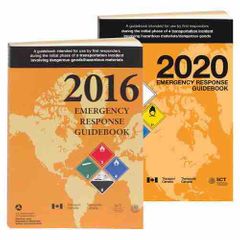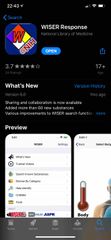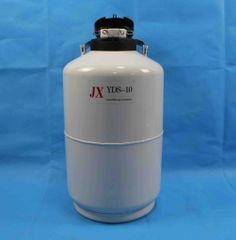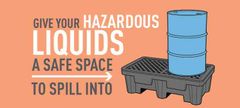![]()
![]()
![]()
Use LEFT and RIGHT arrow keys to navigate between flashcards;
Use UP and DOWN arrow keys to flip the card;
H to show hint;
A reads text to speech;
91 Cards in this Set
- Front
- Back
- 3rd side (hint)
|
Preincident Survey/Preplan |
Assessment of a facility or location made before an emergency occurs, in order to prepare for an appropriate emergency responce |
|
|
|
Packaging |
Shipping containers and their markings, labels, and/or placards |
|
|
|
Manway/Manhole |
Opening that is large enough to admit a person into a tank trailer or dry bulk trailer that is generally equipped with a removable and/or lockable cover |
|
|
|
Cryogenic Liquid |
Gas the is converted into liquid by being cooled below -130 degrees F (-90 degrees C) |
- Displace oxygen and cause asphyxiation - extremely cold and can severely injure skin upon contact |
|
|
Oxidizer |
Any material that readily yields oxygen or other oxidizing gas that readily reacts to promote or ignite combustion of combustible materials |
|
|
|
Intermediate Bull Container (IBC) |
Rigid or flexible portable packaging, other than a cylinder or portable tank, that is designed for mechanical handling. • mechanical handling with a capacity of not more than 3 to 0.45 cubic meters (793 gal-119gal) -or- • a maximum net mass of no less than 400 kg (882lbs) |
|
|
|
Dust Explosion |
Rapid burning (deflagration), with explosive force of any combustible particles in the air |
|
|
|
Label |
Four inch square diamond shaped marker required by federal regulations on individual shipping containers that contain hazardous materials and are smaller than 640 cubic feet (18 cubic meters) |
|
|
|
Placard |
Diamond shaped sign that is affixed to each side of a structure or vehicle transporting hazardous materials to inform responders of fire, life , special , and reactivity hazards. •required in containers 640 cubic feet or larger |
|
|
|
Emergency Response Guidebook (ERG) |
Manual that aids personnel in identifying hazardous placards and labels thereby giving guidelines for initial actions to be taken |

|
|
|
Elevated Temperature Material |
Material that when offered for transportation or transported in bulk packages is intentionally heated |
• liquid phase is at a temp 212 degrees F (100 degrees C) or above • solid phase at temperatures at a temp 464 degrees F(240 degrees C) or above • intentionally heated at or above it’s liquid phase flash points of 100 degrees F (38 degrees C) |
|
|
Globally Harmonized System pd Classification and Labeling of Chemicals (GHS) |
International classification and labeling system for chemicals and other hazard communication information such as safety data sheets |
|
|
|
Safety Data Sheets (SDS) |
Form provided by chemical manufacturers, distributors, and importers that provided information about the chemical composition, physics and chemical properties, health and safety hazards, emergency response procedures, and waste disposal procedures |
|
|
|
CAS Number |
Number assigned by the American Chemical Society’s Chemical Abstract Service that uniquely identifies a specific compound |
|
|
|
Bill of Landing |
Shipping paper used by trucking industry indicating origin, destination, route, and product placed in the cab of every truck tractor |
|
|
|
Air Bill |
Shipping paper used by aviation industry indicating origin, destination, route, and product placed in the cockpit of every plane. |
|
|
|
Trainlist/Consist |
Shipping paper used by railway industry indicating origin, destination, route, and product placed in the Engine or caboose |
|
|
|
Dangerous Cargo Manifest |
Shipping paper used by water shipment industry indicating origin, destination, route, and product placed in the bridge or pilot house of the ship |
|
|
|
Local Emergency Planning Committee (LEPC) |
Community organization composed of local officials, citizens, and industry representatives with the task of designing, reviewing, and updating a comprehensive emergency plan that may address hazardous inventories, hazardous material response training, and assessment of local response capabilities |
|
|
|
Local Emergency Response Plan (LERP) |
Plan detailing how local Emergency Response agencies will respond to community emergencies |
|
|
|
Computer-Aided Management of Emergency Operarions |
A system of software that assists emergency responders in the development of safe response plans |
Like CAD |
|
|
Wireless Information System for Emergency Responders (WISER) |
Electronic resource that brings a wide range of information to the hazmat responder such as chemical identification support, characteristics of chemicals and compounds, Heath hazards, and containment advice |

|
|
|
Olfactory Fatigue |
Gradual inability of a person to detect odors after initial exposure; aka loose sense of smell due to toxins and hazards |
|
|
|
BLEVE |
Boiling liquid/expanding vapor explosion; an explosion that occurs when pressurized liquified materias, such as propane or butane, inside a closed vessel are exposed to a source of high heat |
|
|
|
Drum |
A barrel-like nonbulk storage vessel made of different materials used to store a wide variety of substances including food grade materials, corrosives, and flammable liquids |
|
|
|
Dewar Container |
A container designed to preserve the temperature of the cold liquid held inside |

|
|
|
Bulk Storage Containers |
A large volume container that has an internal volume greater than 119 gallons for liquids and a capacity greater than 882 pounds for solids and gases |
|
|
|
Secondary Containment |
An engineered method to control spilled or released product if the main containment vessel fails |

|
|
|
What are the Seven Clues to the presence of a hazardous material? |
1. Occupancy types, locations, and preincident surveys 2. Container shapes 3. Transportation placards, labels, and markings 4. Other markings and colorings (nontransportation) 5. Written resources 6. Senses 7. Monitoring and detection devices |
|
|
|
Nonbulk storage vessel |
A container such as drums, bags, compressed gas cylinders, and cryogenic containers that hold commonly used commercial and industrial chemicals such as solvents, industrial cleaners, and compounds |
|
|
|
Excepted |
This type of radiation packaging is only used to transport materials with extremely low levels of radioactivity that present no risk to the public or enviornment |
|
|
|
Industrial |
This type of radiation container that retains and protects the contents during Norma transportation activities such as laboratory samples and smoke detectors |
|
|
|
Type A |
This type of radiation packaging must demonstrate their ability to withstand a series of tests without releasing their contents |
|
|
|
Type B |
This type of radiation packaging must demonstrate their ability to withstand tests simulating Norma shipping conditions and they must also withstand severe accident conditions without releasing their contents |
|
|
|
Type C |
Type of radiation packaging that is very rare and only used for high-activity materials (including plutonium) transported by aircraft |
|
|
|
When pipelines cross under or over roads, railroads, and waterways, pipeline companies must provide ________? |
Markers Markers must be in sufficient number along the pipeline to identify the pipelines location. |
|
|
|
In the United States who is in charge of the hazardous material placards? |
The U.S. Department of Transportation |
|
|
|
Canada requires a unique placard for ________ and ________. |
Anhydrous Ammonia & Inhalation Hazards |
|
|
|
What is NFPA 704? |
The Standard System for the Identification of the Hazards of Materials for Emergency Response |
|
|
|
NFPA 704 rates what three things on a scale of 0-4? |
0 being minimal 4 being severe Heath - blue Flammability - red Instability - yellow |
|
|
|
The only two allowed special hazard symbols in the NFPA 704 diamond include? |
reactivity with water = W with a line through it Oxidizer = OX |
|
|
|
This marking system is used when materials are being transported from one location to another. |
DOT Hazardous Material Marking System |
|
|
|
This identification system is designed for fixed facility use. |
NFPA 704 Hazard Identification System |
|
|
|
Hazardous Materials Information System (HMIS) |
A color-coded marking system by which employers give their personnel the necessary information to work safely around chemicals |
|
|
|
This signal word means highly toxic by all routes of entry |
Danger—Poison NOTE: not currently included in the Global Harmonized System of Classification and Labeling of Chemicals (GHS) |
|
|
|
This signal word means severe eye damage or skin irritation |
Danger (One of the 2 signal words in GHS) |
|
|
|
This signal word means moderately toxic |
Warning (One of the 2 signal words included in GHS) |
|
|
|
This signal word means minor toxicity, eye damage, or skin irritation |
Caution NOTE: this signal word is not included in the global harmonized system of classification and labeling of chemicals (GHS) |
|
|
|
The EPA requires a warning label on all containers with polychlorinated biphenyl (PCB) because? |
PCB is a cancer causing agent |
|
|
|
Hazardous materials may be transported without placard when: |
they are in small-quantity packages |
|
|
|
Plutonium and other high-actiity materials are likely to be transported in which type of radioactie materials container? |
Type C |
|
|
|
Spattering or boiling of unheated materials is an example of visualor sensory evidence of what type of reaction? |
Chemical Reaction |
|
|
|
CAMEO, WISER, and 911 Toolkit are examples of: |
electronic technial resources |
|
|
|
In the color code systems ANSI z545.5, red means: |
danger or stop |
|
|
|
Liquefied natural gas (LNG) might be found in what type of container: |
cryogenic container |
|
|
|
The use of both French and English on a label is a feature of the: |
canadian markign system |
|
|
|
Where would shipping papers be located in a truck? |
near the driver |
|
|
|
What type of radioactive packaging must demonstrate its ability to withstand severe accient conditions without releasing its contents? |
Type B |
|
|
|
Which marking system promotes common, consistent criteria for classifying chemicals according to their health, physical and environmental hazards? |
Globally Harmonized System |
|
|
|
Safety data sheets |
can be acquired from the manufacturer of the material |
|
|
|
Excepted, Industrial and Type A, Type B, and Type C packaging are examples of: |
radioactive materials containers |
|
|
|
When attempting to identify hazmat, which clud is most likey to place responders in dangerous areas? |
monitoring and detection devices |
|
|
|
A container holding molten sulfer shoud include the marking: |
HOT |
|
|
|
Chemical Inventory Lists (CIL) might b useful to first responders at a fixed-facility hazmat incident because: |
they can help identify containers that may have been damaged or are missing labels or markings |
|
|
|
Unique numberical identifiers assigned to individual chemicals and chemical compounds, polymers, mixtures, and alloys are called _______ numbers. |
CAS |
|
|
|
Which sense is the safest to use in detection of a hazardous material? |
Vision |
|
|
|
Packaging in which materials are loaded with no intermeiate form of containment is called ______ packaging. |
bulk |
|
|
|
Why might the Emergency Response Guidebook be of limited value in its application at fixed facility locations? |
It is primarily designed for use at incidents occurring on a highway or railroad |
|
|
|
Nine hazard classes are used to categorized hazardous materials in the ________ system |
Untied Nations |
|
|
|
When hazardous materials are transported by _________ accidents may occur more frequently at pumping stations and construction and demolition sites |
Pipeline |
|
|
|
Using monitoring and detection devices is outside the scope of action for: |
awareness level personnel |
|
|
|
reincident surveys may be helpfu for first responders when dealing with hazmat in the workplace, because OSHA's Hazard Communication Standard: |
allows individual employers to choose the labeling and marking systems fr their businesses |
|
|
|
What is a difference between labels and placards? |
there are certain unique labels for which tehre are no equivalent placards |
|
|
|
Why should first responders pay attention to water levels in rivers and tidal areas? |
flow and tidal ariances affect clearance under bridges |
|
|
|
Tankers ( or tank vessels) are examples of : |
vessel cargo carriers |
|
|
|
In general ______ often equates to safety when hazmat identification is involved. |
distance |
|
|
|
Which type of aring system wuld require the use of hazard statements such as harmful if swalowed? |
Pesticide labels |
|
|
|
The ERG can be used by first responders to determine appropriate initial response information at a hazmat incident, provided they know the materials: |
four-digit identification number |
|
|
|
what does the special marking OX indicate in the NFPA 704 marking system? |
an oxidizing material |
|
|
|
Pesticides and anhydrous ammonia are most likely to be found at which type of occupancy? |
farms |
|
|
|
How do general caution symblos in Mexico differ from those in the U.S.? |
They are triangular rather than round |
|
|
|
Pipelines transport: |
liquids and gases |
|
|
|
What type of radioactie packaging is recommended for laboratory samples and smoke detectors? |
Industrial |
|
|
|
A container with V-shaped sloping sides with bottom outlets is liekly carrying: |
Solids |
|
|
|
Which type of container is used to transport hazardous materials on a plane? |
Unit loading device |
|
|
|
Small airborne particles that are ignited in an enclosed location can cause a: |
dust explosion |
|
|
|
Two common labels used in the Canadian Workplace Haardous Materials Informatioin System are the workplace label and the _______ label. |
supplier |
|
|
|
When stressed, pressure containers can rupture violently due to: |
internal pressure |
|
|
|
Containers are often classified according to their transportation mode and: |
capacity |
|
|
|
Cargo tanks, railcars, and portable tanks are examples of which packaging type? |
bulk packaging |
|
|
|
Rounded almost spherical ends indicate what type of container? |
Pressure container |
|

